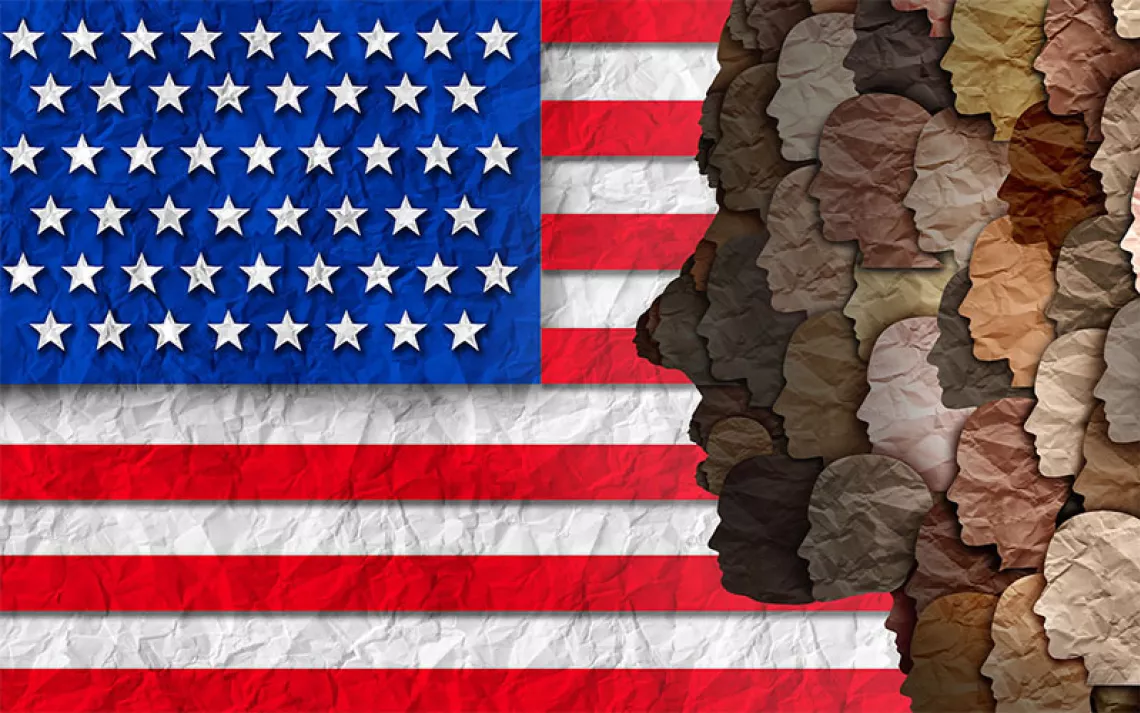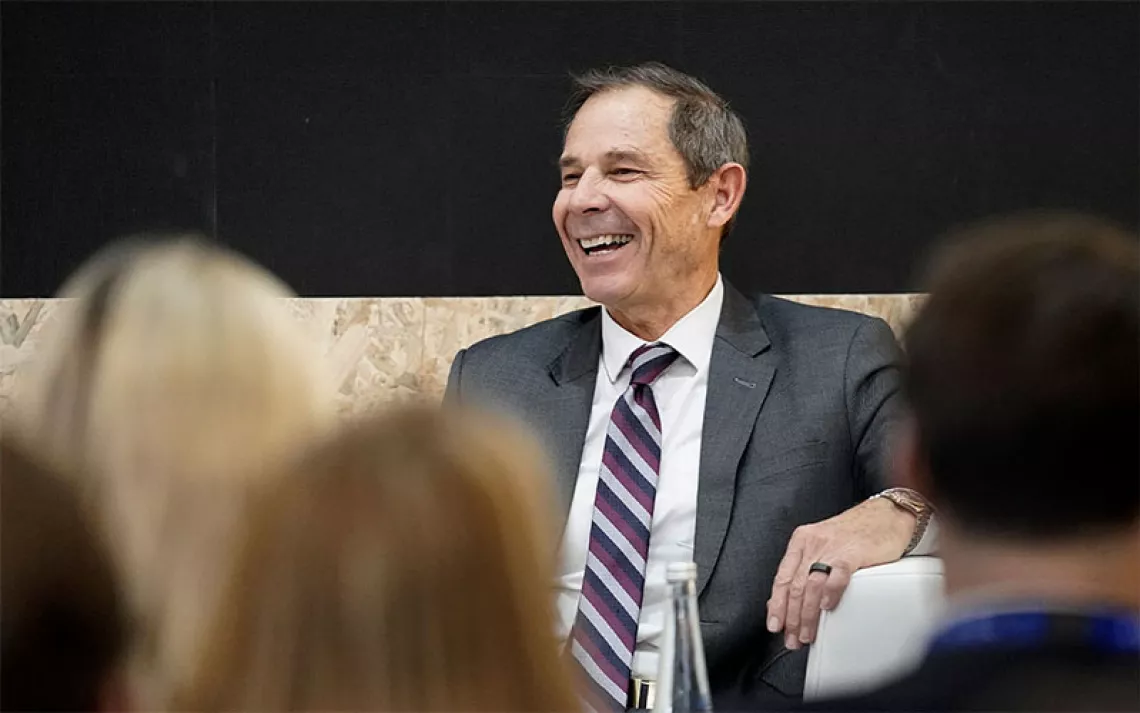This Year Could Be the Breaking Point for One of America's Greatest Wildlife Refuges
The outcome of the election will decide the fate of Alaska’s Arctic National Wildlife Refuge

On the North Slope of the Brooks Range in the Alaska National Wildlife Refuge, pristine rivers run toward Prudhoe Bay. | Photo by Cassidy Randall
In the last week of July 2023, on the cusp of Arctic autumn, my husband and I listened to the whir of a bush plane fade into the distance until all that remained was deep quiet. The pilot had dropped us at the headwaters of the Ivishak River, quickly unloaded our gear, and just as quickly taken off. My breath hitched. We were now profoundly alone, tiny dots in one of the largest remaining expanses of wild landscape in the world.
I’m from Montana. I’m no stranger to big wilds. But the Arctic National Wildlife Refuge, spanning 19.6 million acres of northeast Alaska from the Brooks Range to the ocean, dwarfs anything in my comprehension, so much so that it had become symbolic in my mind as an archetype of unspoiled wildlands. We planned to hike and paddle nearly a hundred remote miles of it, through tussock and stone and the clear water of the Ivishak. An eight-day trip, with just the two of us, for our honeymoon. We’d start in the dinosaur-old mountains that make up the North Slope of the Brooks Range, paddle through the tundra, and end at the Dalton Highway that connects Fairbanks and Prudhoe Bay.
We chose the end of the route, at the highway, to avoid the high cost of a second bush plane flight—naively failing to consider the nerve-jarring transition from wilderness to oil infrastructure that we’d inevitably run into. Prudhoe is synonymous with Arctic drilling, which is partly why the Arctic Refuge is also emblematic in the national psyche as ground zero in the fight against climate change. We were about to cut through the symbolism, though, and run head-on into the real stakes of the refuge’s status as a political sacrificial lamb coming into a critical election year.
But before the jar would come the wonder.
Over the course of our trip, we hiked past huge bear scat and the dragged bones of a moose. One morning, we heard a single wolf howl, far distant. We paddled along shores thick with tracks, although glimpses of wildlife were scarce. It was an unseasonable 80 degrees, unusually hot even for summer, and everything smart was bedded down. As to other people, we saw no evidence.
I had never felt so small. And I had never understood how essential that feeling is to the humility of the human spirit and our understanding of our place on the planet. Paddling one day just before the mountains gave way to tundra, the river swelled to oceanic before splitting apart again in a lacework of braids. I looked over at my husband floating beside me. He was gazing at the landscape sliding slowly by, so moved by the depth of this wild that tears ran down his face. He was in awe, in the true self-transcending sense of the word.
But not everyone agrees there’s value in retaining such a vast wild for the sake of it, and the fate of this pristine pocket of the world has been in limbo for decades. Alaskan state officials have advocated for opening parts of the wildlife refuge to drilling for the oil suspected to be stored under the surface, largely thanks to the political capital of oil dividend checks state residents receive from extraction. The Gwich’in, whose ancestral homeland overlaps with the refuge and who still rely on the land for subsistence, have been fighting for decades to keep oil and gas out, joined by environmental organizations in Alaska and beyond. Even the Inupiat residents of Kaktovik on the coast, the recipients of possible oil jobs, are sharply divided on the issue. As a result, the Arctic Refuge, unlike its neighbor, the Gates of the Arctic National Park and Preserve to the west, remains unprotected from development.
In 2017, the Trump administration forced oil and gas lease sales in the refuge by slipping a provision that required them into the Tax Cuts and Jobs Act. Then, his administration rushed to finalize the measure just two weeks before President Biden’s inauguration. In September 2023, the Biden administration canceled those leases as part of its climate action plan. However, without major congressional action, no administration will be able to permanently protect the Arctic National Wildlife Refuge. In fact, it’s still bound by the 2017 mandate to conduct another lease sale in December 2024. Although Democratic presidential nominee Kamala Harris hasn’t definitively announced her position on the refuge, she said in her 2020 presidential campaign that she would ban fossil fuel leases on public lands if elected, has prosecuted oil companies for spills and illegal emissions, and, according to the Washington Post, has a long history of “commitment to climate and environmental issues.”
In contrast, the plan for the first one hundred days of a Republican administration emphasizes reversing Biden’s climate change policies ... starting with drilling in the Arctic Refuge.
Midway through our journey, I had come to a new understanding of humanity’s smallness and our outsized power over the planet. Although we were still traveling through the refuge's pristine interior, the effects of fossil fuel extraction obviously don’t stay confined to developed areas.
For this journey, we’d prepared for cold temperatures, inclement weather, and close encounters with big carnivores, including the polar bears wandering farther inland. What we hadn’t prepared for were the thunderstorms. To our credit, though, they used to be rare in the Arctic and are a new phenomenon because of climate change. They manifested themselves in towering clouds and lightning that chased us off the river each day around mid-afternoon. By the time we’d paddled out into the tundra, the landscape no longer offered shelter.
On day six, my husband and I cowered in our tent pitched amid a patch of stubby willows, laughable cover from the most monstrous storm cell I’d ever experienced. We both spent the hour and a half it stood on top of us—thrashing us with rampaging wind, the lightning and thunder erupting in our bones—wondering if each moment was our last.
When it was over, we decided we’d prefer to skip our last night on the tundra rather than survive another Arctic thunderstorm. Instead, we woke early and paddled all the way out to the Dalton Highway in one push, eschewing the scheduled ride we’d coordinated in favor of hitching one back a day early to the safety of buildings and more topography.
And here was that nerve-jarring moment. To reach the road, a mile from the river, we had to duck under the silver girth of the Trans-Alaska Pipeline, wide as a semi tank. After traversing what seemed a boundless, wild expanse, we were abruptly interrupted by a manmade, tangible border signaling that wild’s decisive end. The pipeline operates 24/7, 365 days per year. At its peak in 1988, it transported more than 2 million barrels a day. The flow has steadily decreased—as the oil to be drilled dries up—to just under half a million barrels now.
After we cleared the pipeline, we reached the highway at an awkward time. Tourist traffic leaving Deadhorse in Prudhoe Bay had long since ceased, limiting our hitching options. It was hot on the pavement because the Arctic is warming four times faster than the rest of the planet; temperatures recently soared to a record high of 89°F in Deadhorse in early August. We counted ourselves lucky when a double-tanker truck stopped and its driver waved us into his cab. He told us he drove the Haul Road, as the Dalton Highway is called in deference to its priority status for serving oil infrastructure, three times per week, all year, transporting oil to Fairbanks. We passed scores of trucks on the same mission, paralleling the pipeline and all it was already carrying. Dust kicked up by so many wheels mixed with the acrid tang of diesel.
This scene acted as a glimpse: This could be the fate of the clean and quiet expanse of the Arctic National Wildlife Refuge, through which we’d just passed, if we fail to protect it from drilling. That outcome hangs by the thread of this single, upcoming election, all those decades of limbo now crowded up against one 11th-hour decision.
Well, not one, exactly. There are 244 million Americans registered to vote. Each one of those millions of decisions in this election matter, and they are not merely symbolic. Our votes create real outcomes in real places that impact the future of the planet.
Personally, I’m deciding in favor of one of the last great wildernesses left.
 The Magazine of The Sierra Club
The Magazine of The Sierra Club



